The HTMS Krabi offshore patrol vessel is built by Thai naval shipbuilder Bangkok Dock under a licensing agreement with BAE Systems, to meet the specific operational requirements of the Royal Thai Navy (RTN).
 Image – @static.progressivemediagroup.com
Image – @static.progressivemediagroup.com
The vessel is intended to conduct routine patrols, border control and fishery protection missions in Thailand’s exclusive economic zone (EEZ) and can also be deployed to perform disaster relief operations and natural resources protection in the Gulf of Thailand and the Andaman Sea.
Krabi-class vessels construction
BAE Systems signed a technology transfer agreement with Bangkok Dock to supply the 90m offshore patrol vessel design for the construction of HTMS Krabi in Thailand in June 2009.
 Keel laying ceremony of HTMS Krabi (551), worth THB2.8bn (approximately $79.2m), was held in August 2010 and the vessel was launched at Mahidol Adulyadej Naval Dockyard in November 2011. It was inducted into the RTN’s service in August 2013 and has completed 1,000 days of operation at sea.
Keel laying ceremony of HTMS Krabi (551), worth THB2.8bn (approximately $79.2m), was held in August 2010 and the vessel was launched at Mahidol Adulyadej Naval Dockyard in November 2011. It was inducted into the RTN’s service in August 2013 and has completed 1,000 days of operation at sea.

HTMS Krabi took part in the International Fleet Review 2013 organised by the Royal Australian Navy in Sydney Harbour, Australia, in October 2013.
In January 2016, BAE Systems received a contract from Bangkok Dock to provide design and engineering support for the second 90m offshore patrol vessel, which is estimated to cost THB5.5bn (approximately $155m).
Design and features of Krabi vessel
 HTMS Krabi
HTMS Krabi
The design of HTMS Krabi vessel is based on 90m offshore patrol vessel, an evolution of the 80m River-class offshore patrol vessel (OPV), which is designed and built by BAE Systems for the UK Royal Navy.
HTMS Krabi is 90.5m-long, 13.5m-wide and 7.7m-high, and has a draft of 3.8m. With a displacement of 1,969t, the vessel can accommodate up to 39 crew members plus 50 embarked personnel.
 HTMS Krabi (551)
HTMS Krabi (551)
The vessel is operated from the navigation bridge, located amidships. The marine radars and communications systems are attached at the top of the bridge.
Helicopter landing system

A large 20m flight deck at the aft section supports the operation of a Super Lynx multi-purpose military helicopter. The vessel also carries a rigid hulled inflatable boat (RHIB) on both sides to perform patrol and transportation tasks.
The OPV is installed with air-conditioning and electrical systems, storage and accommodation facilities, as well as a crane to lift equipment.
RTN Super Lynx landing on HTMS Krabi
Second OPV project 552 ร.ล.ตรัง “HTMS Trang” Change to “HTMS Prachuap Khiri Khan”
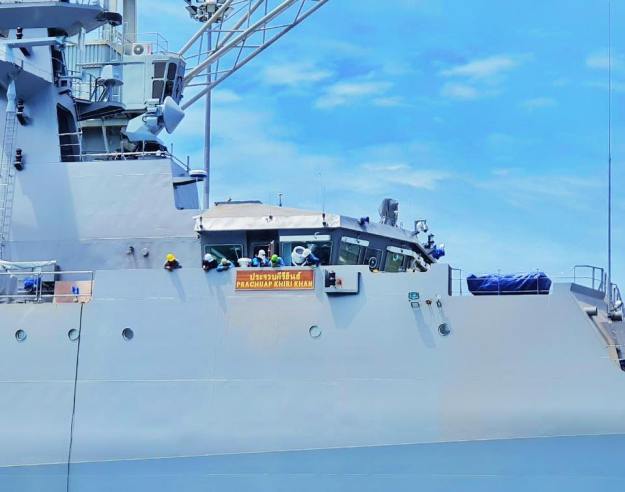
HTMS Prachuap Khiri Khan – Navy For Life
Today (25 June 2019) 09.30 hrs. Admiral Chatchai Sriworakhan, Chief of Naval Staff as Chairman Bangkok Garage Company Limited is the Chairman of the Board of Directors of Bangkok Garage Company Limited No. 6/2562 at the Mahidol Adulyadej Navy Naval Department, Sattahip District, Chonburi Province After the meeting of the Chief of Naval Staff As Executive Chairman Led the board And related persons Check the progress of building a royal boat, Prachuap Khiri Khan and prepare At the ceremony, leaving the Royal Navy Khan overboard by the current in the ship building progress to more than 90 percent . HMS. Khan HTMS Prachuap Khiri Khan offshore patrol (ship kg.) A Offshore Patrol Vessel (, OPV). Motto “Brave Frontier ” “Frontier, Fearless” Credit Photo: WO552 By Admin. Source aagth1.blogspot.com

HTMS Prachuap Khiri Khan – Kawin Prayoonyuang

The navy will build its second offshore patrol vessel, this one to be armed with guided missiles, at an estimated cost of 5.5 billion baht.
Vice Adm Jumpol Lumpiganon, deputy chief-of-staff and spokesman for the Royal Thai Navy, said on Monday the first OPV the navy built was HTMS Krabi.
The second offshore patrol vessel would be developed from the design of the first OPV, which was based on a design by BAE Systems Ships Co of England, he said.
The navy had signed a contract to buy the vessel’s design and materials from Bangkok Dock Co, a state enterprise under the Defence Ministry. The Mahidol Naval Dockyard of the Naval Dockyard Department would build the vessel and the Naval Ordnance Department will be responsible for its weapons systems. Source Bangkok Post

HTMS Prachuap Khiri Khan – Kawin Prayoonyuang
Aside from the BAE Systems’ enhanced design, the ship has helipad capable to accommodate the 11.5-ton helicopter or S-70B in RTN. RGM-84 Harpoon will be installed on board the ship and most of electronic systems are from Thales. Source TAF

HTMS Prachuap Khiri Khan can accommodate 11.5 ton helicopter like the RTN S-70B – SATTAHIP NEWS
Royal Thai Navy lays keel for second OPV: Here
Excerpt
The Royal Thai Navy (RTN) has laid down the keel for its second 90 m offshore patrol vessel (OPV), which it is building in collaboration with BAE Systems.
The keel laying ceremony was held on 23 June at the RTN’s Mahidol Adulyadej Naval Dockyard in Sattahip, Chonburi, a facility managed by state-owned company Bangkok Dock.
Progress of the 2nd OPV Shipbuilding Project “HTMS Prachuap Khiri Khan”
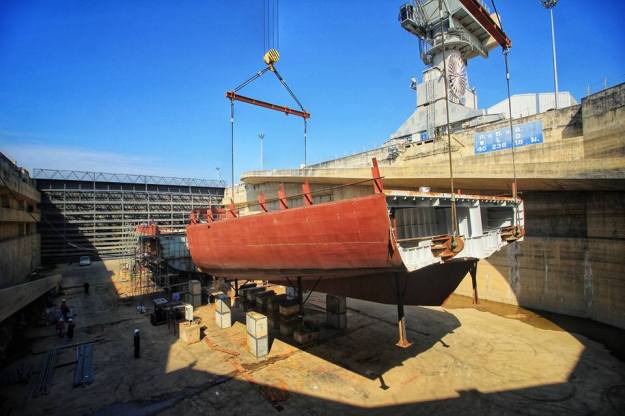 Image: Pound Wattanamongkol
Image: Pound Wattanamongkol
Armament to combat shore-based targets HTMS Krabi
An Oto Melara 76mm lightweight naval gun, developed by Italian OTO Melara, is installed on the bow. With a rate of fire of 120 rounds a minute, it is designed to provide defence against shore-based targets.
Oto Melara 76mm lightweight naval gun
 HTMS Krabi (551)
HTMS Krabi (551)
The Oto-Melara / Oto-Breda 76/62SR 76mm (3-inches) 62-caliber Super Rapid gun is a lightweight, automatic loading, rapid fire naval gun system used against shore, sea and air targets.
Manufacturer: 1963-2001 Oto-Melara / 2001- OtoBreda
Produced: Compact: 1963- / Super Rapid: 1988-
Technical data:
Caliber: 3 inches / 76,2 mm
Barrel lenght: 186 inches / 4,72 meters (= 62 caliber)
Weight: 7900kg, empty (Super Rapid)
Shell: 76 x 900 mm / 12,34 kilograms
Elevation: – 15° to + 85°
Traverse: 360°
Rate of fire: Compact: 85 rpm / Super Rapid: selectable from single shot up to 120 rpm
Muzzle Velocity: 925 m/s (1100 m/s – DART)
Magazine: Compact: 80 rounds / SR: 85 rounds
Range:
16 kilometers with standard ammunition
20 km with extended range ammunition
up to 40 km with VULCANO ammunition
Evolution:
– Compact
– Super Rapid
– Stealth casing
– DAVIDE/STRALES radio frequency guidance system for DART guided ammunition
 The revolving ready-ammunition magazine for one of the 76mm gun mounts.
The revolving ready-ammunition magazine for one of the 76mm gun mounts.
Ammunition:
– HE (high explosive) – 6,296kg / Range 16km / effective range 8km (4km vs. air targets at elev. 85°)
– MOM (multi-role OTO munition)
– PFF (pre-formed fragmentation) – anti-missile ammunition
– SAPOM (semi-armored piercing OTO munition) – 6,35kg / Range 16km
– SAPOMER (semi-armored piercing OTO munition, extended range) – Range 20km
– DART (driven ammunition reduced time of flight) – sub-calibre guided ammunition against multiple targets
(missiles and maneuvering targets at sea) 4,2kg in barrel / 3,5kg in flight / 660mm lenght / effective range >8km
– VULCANO (76mm unguided and guided extended range ammunition) – under development
Source seaforces.org
Two dual-feed MSI 30mm guns, fitted on both port and starboard mounts, offer protection against light targets. The offshore patrol vessel is also armed with general-purpose machine guns.
Two dual-feed MSI 30mm guns
 HTMS Krabi (551)
HTMS Krabi (551)
Features and Options include:-
- 25 & 30mm cannon options
- Thermal Imager: 4th Generation Staring FPA. 3-5µm
- Colour TV Camera
- Laser Range Finder
- Automated acquisition, tracking and ballistic computation
- High Accuracy low dispersion
- Single / Dual ammunition feed option
- Reversionary local control
- Wide range of ammunition types including air burst munitions
- Open architecture allowing maximum integration with shipboard systems
- 24hr day surveillance and target ranging from EO sensors
Source msi-dsl.com
The second patrol vessel in the class can be equipped with a RGM-84 Harpoon anti-ship missile.
Thales reveals weapons configuration of the RTN’s second OPV 552 “HTMS Prachuap Khiri Khan”

HTMS Prachuap Khiri Khan – Kawin Prayoonyuang
Main gun will be Oto Melara 76/62 compact stealth shield and two MSI-DSL/ATK 30 mm DS30MR Mk.44. There are also an preparation for the anti-ship missile to be installed. RTN is looking at the RGM-84D Harpoon, but if there is any export ban RTN will shift to C-802A instead. But ThaiArmedForce.com believe that the Harpoon deal, if it is exist, will go through consider United States just approve the additional sale of RIM-162B ESSM to the RTN. The two Terma DL-12T will make this ship the first RTN ship that capable of avoiding the anti-ship attack.
Oto Melara 76/62 compact stealth shield

HTMS Prachuap Khiri Khan – Navy For Life
Oto Melara 76/62 compact stealth shield . The gun’s high rate of fire and availability of specialised ammunition make it well-suited to varied roles such as short-range anti-missile point defence, anti-aircraft, anti-surface, and ground support. Specialised ammunition includes armour piercing, incendiary, directed fragmentation effects, and a guided round marketed as capable of destroying manoeuvring anti-ship missiles.
2 x MSI-DSL/ATK 30 mm DS30MR Mk.44

HTMS Prachuap Khiri Khan – SATTAHIP NEWS
RGM-84D Harpoon
 RGM-84D Harpoon
RGM-84D Harpoon
The Harpoon is an all weather, subsonic, over the horizon, anti-ship missile which can be launch from surface ships, submarines and aircraft. Its guidance system consists of a 3-axis integrated digital computer/ radar altimeter for midcourse guidance, and an active radar seeker for the terminal phase of the flight.
The Harpoon flies at subsonic speeds, with a sea-skimming flight trajectory for improved survivability through reduced probability of detection by enemy defenses. It was designed to strike enemy ships in an open ocean environment.
The ship launched RGM-84 Harpoon was introduced in 1977, as well as the encapsulated submarine launched UGM-84.
Dimensions
Diameter: 340 millimeter
Length: 4.63 meter (15.2 foot)
Wingspan: 910 millimeter
Performance
Max Range: 124 kilometer (67 nautical mile)
Speed
Top Speed: 237 mps (853 kph)
Weight
Thrust: 660 pound
Warhead: 224 kilogram (494 pound)
Weight: 691 kilogram
Source deagel.com
2 x 4 Harpoon launchers
2 x 4 Harpoon launchers
Safran’s Sigma 40 integrates with Harpoon missile system: Here

Sigma 40: laser gyro technology inertial navigation system

The Sigma 40 inertial navigation system is making use on laser gyro technology. An advanced system designed by Sagem for maritime applications, the Sigma 40 meets the most demanding navigation and weapon system stabilization requirements.
Both an inertial attitude and heading reference system, the Sigma 40 offers high performance and precision for all sizes of surface vessels. Both compact and robust, the Sigma 40 delivers all data needed for navigation: heading, roll and pitch, angular velocity, position and heave, vertical/horizontal speed and acceleration.
The Sigma 40 is suited to all types of platforms, including fast patrol boats, mine-hunters, corvettes, frigates, aircraft carriers, etc. It comprises an inertial navigation unit (INU), control and display unit (CDU) and an installation bracket, for fast removal and reassembly without recalibration. Both innovative and scalable, the Sigma 40 is easy to install, maintain and operate. Source safran-electronics-defense.com
The main features of RLG Sigma 40 are :
- It has got high-level performance
- It has very simple installation requirements
- It has very convenient operation procedure.
- It does not requires any preventive maintenance.
- It consists both Synchro and digital interfaces. There is no need to provide any extra hardware interface.
- It is IMO approved and military standards certified.
- It is very reliable and rugged.

The core aim of RLG sigma 40 is :
- To provide the target navigational data like heading, roll, itch etc in real time.
- To regularly update the target navigational data like speed and velocity.
- Interfacing of other navigational inputs from/to other Navigational equipments like EM Log, GPS, DGPS, Radar, Anemometer etc.
Sub-Units of RLG Sigma 40:
The RLG Sigma 40 system contains four basic sub-units. They are as follows:

Components of Ring Laser Gyro Sigma 40 – Image @electricalfundablog.com
CDU stands for Control and Display Unit
DDU stands for Data distribution unit, and
UPS stands for Uninterrupted Power Supply
The Inertial Navigation Unit of basic RLG Sigma 40 unit consists of the following sub-units:
- Inertial Sensor Block (referred as BSI)
- Basic Synchro Module
- EB Module
- UTR-SP Module
- Interface module (or RS 422 Module)
- Power Supply Unit
- HT/ THT Module
 Composition of Inertial Navigation Unit – Image @electricalfundablog.com
Composition of Inertial Navigation Unit – Image @electricalfundablog.com
The Inertial Sensor Block (BSI) consists of the various sensors. They are :
- Laser Gyros (Model GL S32) 03 in numbers : It senses Angle of Rotation and Speed of Rotation.
- Accelerometers (Model A-600) : It senses the acceleration.
- EACC : It consists the circuitry for controlling the Pendulum of Accelerometer using servo elements. In addition to that, It also contains the EEPROMs which stores the sensor’s calibration data.
** EEPROM stands for Electrically Erasable Programmable Read Only Memory.
Source electricalfundablog.com
.50 cal General-purpose machine guns
 2 x 50 cal General-purpose machine guns – HTMS Krabi (551)
2 x 50 cal General-purpose machine guns – HTMS Krabi (551)
HTMS Krabi navigation and communication




HTMS Krabi is integrated with a variety of sensors developed by Thales, such as Lirod Mk2 fire control radar, Variant surveillance radar, FIT 10 Voice Terminal, Tacticos combat management system (CMS), FOCON IP communication system, MOC mk3 consoles, TSB 2520 IFF interrogator and combined interrogator transponder (CIT), and integrated communication system.

Lirod Mk2 fire control radar
 Lirod Mk2 fire control radar HTMS Krabi
Lirod Mk2 fire control radar HTMS Krabi

LIROD MK2 is a flexible and compact sensor system, most suitable as an accurate, low cost, all-weather tracker for fire control systems.
The system has been designed for as the primary gun control system onboard of smaller ships, against both surface and air targets, and as a secondary system in larger configurations. With an appropriate gun, it is suitable for CIWS functions. LIROD Mk2 is also capable of controlling short-range missiles.
The radar system operates in the K-band, and applies a new, powerful TWT transmitter to improve the performance under adverse conditions. The antenna is of an ellipsoid design to achieve the best low elevation performance against sea-skimming targets, while maintaining fast target acquisition against manoeuvring targets.
LIROD Mk2 has been purchased by the navies of Indonesia, Turkey, Greece, Morocco and Thailand. Source thalesgroup.com
Variant – Lightweight 2D short to medium-range surveillance radar

Variant surveillance radar
VARIANT is a multipurpose, short/medium range 2D radar, simultaneously operating in the X and C-band for air and surface surveillance. It can track surface targets up to 70km and air targets up to 120km. Its principal role is as an automatic, fast reaction time radar sensor supplying targeting data to weapon systems. Its extensive features make VARIANT the answer in modern warfare, littoral and asymmetric threat environments. VARIANT provides air tracks without any operator intervention (auto target initiation and tracking). For surface targets, three fire control channels are available to support direct target engagement. The system is completed by an integrated Low Probability of Intercept (LPI) surface surveillance radar (SCOUT).
Source thalesgroup.com
TACTICOS MOC Mk.3 console station
FIT 10 Voice Terminals
- 1- Multifunction terminal
- 2 – focon ruggedized terminal
- 3 – Receptacle extension unit
IP-based voice and data communication system
Integrating all communication subsystems into ONE solution
Multi-service communication network (voice and data)
Red / Black separation with multiple security levels
100% non-blocking transport of time-critical services
Full integration of IP and non-IP (legacy) equipment and subsystemsRadio and SATCOM integration and distribution
Crypto integration and distribution
Tactical Data Link integration and distribution (L11, LY, L22 …)
Conference and point-to-point connections in various modes
Modular design to fulfil all customer needs
Focon IP Naval LAN
No single point of failure
- Survivability
- High level of redundancy
- Extremely fast automatic reconfiguration
- Flexible allocation of communication assets
- High data rate due to fibre optic interconnections
- Low cost and efficient ship building installation
- A high degree of future upgrading

TSA/TSB 2520 M-Scan IFF Interrogator/CIT
- For aircraft and surface radar
- Qualified on Mig 29, NH90, Gripen
- Dimensions (WxHxD): 157x193x332 mm
- Weight: 8.8 kg
- Available in a 19″ rack
- 1500 W Antenna Amplifier Unit (AAU appliqué)
– Dimensions: 33x193x313 mm
– Weight: 2.7 kg
Source thalesgroup.com
Thales reveals sensor configuration of the RTN’s second OPV 552 “HTMS Prachuap Khiri Khan”
Royal Thai Navy is on the preparation process of building its new OPV, the second of the Krabi class, and they still choosing Thales Nederland as lead system and combat system integrator. The second ship will have a higher capability.

HTMS Prachuap Khiri Khan – Kawin Prayoonyuang
TACTICOS still a combat suite for the yet-to-be name OPV. 4 MOC Mk.3 console station will be installed along with two large collaboration wall displaying the situation picture.
The air-surface surveillance radar will be the rotating 2D dual C/X-band TWT Variant radar along with rotating 2D X-band FMCW LPI solid-state Scout surface-helicopter control radar. Mk X(A) TSB2525 and STIR 1.2 EO Mk 2 is the main fire control. R-ESM capability rely on Vigile Mk 2. L3 Wescam MX-10MS optronic surveillance system and Terma SKWS C-Guard, X-Band and S-Band Sperry Marine Vision Master radar, Furuno ARPA radar will also be installed.
2D dual C/X-band TWT Variant radar (See above)

HTMS Prachuap Khiri Khan – SATTAHIP NEWS
 SURFACE SCOUT – Medium range covert Surface Surveillance Radar
SURFACE SCOUT – Medium range covert Surface Surveillance Radar

As a X-band, short-to-medium range, Frequency Modulation Continuous Wave surface surveillance and navigation radar, Surface Scout is a fully solid-state system with high reliability, low weight and small dimensions.
Surface Scout is the undisputed market leader among maritime Low Probability of Interception (LPI) radars.
Surface Scout features improved detection capabilities on small targets because of an increased (but still very low) output power and reduced rotation speed also for mobile, shelterised or fixed operation
Source thalesgroup.com
STING-EO Mk2

STING-EO Mk2, Thales’s lightweight dual band (I and K) weapon control system, supports gun fire control, performs kill assessment and makes a valuable contribution to classification and identification of threats. In addition, the system can be used as a surveillance sensor, even under radar silence conditions.
The three data sources (I, K, EO) provide high redundancy, performance and ECCM resistance. STING EO Mk2 incorporates the latest solid-state I-band and K-band radars transmitters (low life cycle cost and high operational availability) and a new generation of electro-optical components (especially a third generation focal plane array infrared camera).
For operation in the littoral environment, STING EO Mk2 offers a list of benefits, such as: superior stealth target detection in strong (land) clutter, higher resistance against more stressing jamming scenarios and an extended EO capability for target identification and observation.
Source thalesgroup.com

HTMS Prachuap Khiri Khan – SATTAHIP NEWS
Thales Vigile

The Thales Vigile is a fourth generation electronic support measures (ESM) system tailored for naval applications (both surface and submarine).
The Vigile system provides wideband, high sensitivity reception (C to J bands) and pulse analysis with the ability to detect low probability of intercept (LPI) or invisible hostile radars using ultra sensitive search mode. The wide-open system architecture provides 360° coverage and 100% Probability of Intercept.
Furthermore, this ESM supports electronic intelligence (ELINT), precise de-interleaving, and specific emitter identification/platform identification using ESM tasked mode measuring signals frequency, phase and amplitude.

The system provides real, multiple, instantaneous radar acquisition and handling of up to 500 tracks. Also adaptable library generation by flexible programming and “on task” modification/updating capability to maximise the ability to cope with new tactical situations is provided.
When coupled with the Scorpion ECM system, this system provides a powerful EW suite capable of responding to any threat with very low latency.
The Vigile family consists of Vigile-400, Vigile-300, Vigile-200, Vigile-100 and Vigile-LW (Light Weight). Source thales7seas.com
USN, USAF, Royal Thai Navy select L3 WESCAM in $90 million order: Here
MX-10MS
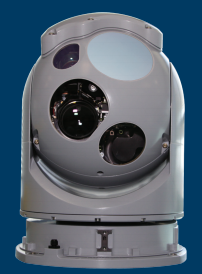
Ideal for: Surveillance, vessel threat detection, covert operations, naval remote weapon stations
Installations: Manned and unmanned marine vessels
Features & Benefits
Multi-sensor Imaging & Lasing Payloads:
- Supports up to 6 sensors simultaneously
- HD color sensor with large ratio optical zoom
- High resolution thermal sensor for imaging at night and under poor weather conditions
- High sensitivity EMCCD sensor for low-light imaging
- High magnification HD color spotter for increased range
- Laser rangefinder

Advanced Image Processing:
- Real-time image enhancement on all sensors
- High performance contrast enhancement and haze penetration
- Improved feature recognition and ID
- Image blending of EO and IR imagery into a single stream
- Automatic Video Tracker (AVT) reduces operator burden
- 2x and 4x Ezoom
Uncompromised Design:
- 4-axis design with built-in passive vibration isolation
- Precision optics provide wide-angle through to high-magnification context
- IMU mounted directly to optical bench for precise GEO-Location
- Robust automatic image focus
Ruggedness:
- MIL spec environment and EMC qualified – humidity, salt, fog and waterproofness
- Extensive testing for mud, salt and water resistance
- Rigorous environmental stress screening (ESS) program
Installation Convenience and Flexibility:
- Compact, lightweight package
- Integrated electronics unit, GPS receiver and video tracker simplifies integration and saves weight

Source wescam.com

Terma SKWS C-Guard
 Terma DL-12T.
Terma DL-12T.

Two Terma DL-12T. Terma’s C-Guard Soft-Kill Weapon System is a decoy system for naval platforms made to defeat stream attack with multiple missiles and torpedoes from multiple directions. The system will effectively counter advanced threats like small range gate Radio Frequency (RF) missiles, imaging Infra Red (IR) seekers missiles, and advanced next generation torpedoes. These threats require fast response and utilization of advanced tactics supporting the latest in decoy technologies available.
Sperry Marine Vision Master radar
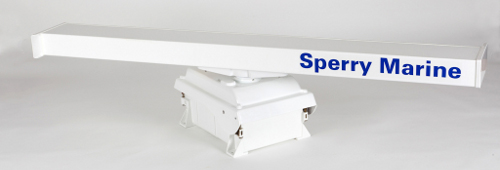 X-Band and S-Band Sperry Marine Vision Master radar
X-Band and S-Band Sperry Marine Vision Master radar
Scanner Features
Scanner features include advanced clutter suppression, target acquisition, AIS targets, interswitching, compatibility, dual-channel options and personalisation.
Advanced Clutter Suppression
In the presence of sea or rain clutter, our VisionMaster FT Radar scanner features advanced clutter suppression technology that automatically detects small, weak targets without the need for adjusting controls.
Target Acquisition
Rather than manually acquiring targets, the ARPA scanners automatically and safely acquire and track targets at relative speeds up to 150 knots.
AIS Targets
The VisionMaster FT Radar can display AIS targets and supports processing and display of AIS ATONS, Search & Rescue Craft, AIS SARTS, AIS Base Stations, safety messaging and AIS MKD.
Interswitching
An optional digital Interswitch allows the operator to display radar video from any scanner at any desired display. For improved user operation and flexibility, interswitching gives up to six transceivers and up to six displays
Compatibility
To reduce cost and time required for retrofit, our VisionMaster FT Radars are compatible with the BridgeMaster-E product line by partial hardware and software replacement.
Personalisation
Settings can be customized for different watch officers, with voyage plans and operating systems that can be saved and moved to different vessels, offering flexibility, control and safety.
Source sperrymarine.com
Furuno ARPA radar
 Furuno ARPA radar console (example) – Image @Furuno
Furuno ARPA radar console (example) – Image @Furuno
The ADS-B and AIS are also believed to be install on board.
Thales also providing the FICS integrated communication system and FOCON IP phone (see above). Network centric mission will go through Thales Link Y Mk.2 that enable the ship to share information with allied force. Thales also integrating the Link RTN developed by Avia Satcom/Rohde & Schwarz. SATCOM will be using Cobham Sailor and underwater communication will be using Ocean Technology Systems Aquacom to communicate with diver. The LRAD also be installed for law enforcement mission.
Thales Link Y Mk.2
 Network centric mission Thales Link Y Mk.2 second OPV @thalesgroup.com
Network centric mission Thales Link Y Mk.2 second OPV @thalesgroup.com
Naval version (“shipborne”)
Link Y Mk2 is built in a compact housing compliant to military standards that meet the requirements for equipment in a naval environment. The naval version is to be integrated into any Combat Management System, e.g. TACTICOS, for surface vessels or submarines. Alternatively, the naval version can be delivered with a local control station to act as a standalone system on board. Source thalesgroup.com
 Thales Network centric @thalesgroup.com
Thales Network centric @thalesgroup.com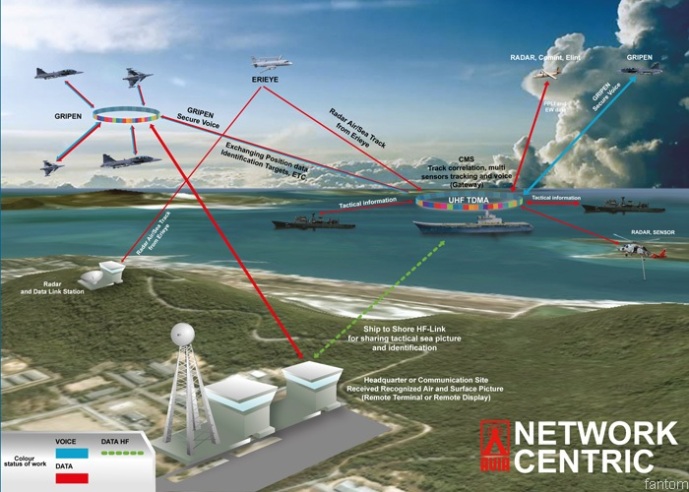 Thales Network centric to integrate with RTN developed by Avia Satcom/Rohde & Schwarz
Thales Network centric to integrate with RTN developed by Avia Satcom/Rohde & Schwarz
Cobham Sailor
 SATCOM will be using Cobham Sailor (example)
SATCOM will be using Cobham Sailor (example)
The Royal Thai Navy will be equipped with the LRAD 500 X to support Law Enforcement at Sea, HMS Trang or the far offshore patrol. At present, the vessel is being operated by the Royal Naval Hospital Mahidol. The supplies In the shipbuilding. The LRAD 500 X Long Range Acoustic Device (LRAD) will be installed in support of marine law enforcement. It is the first ship. To install the device, use it with HMS Krabi.
The LRAD 500 X is a Non Lethal Weapon that can be used on land (car or building), aircraft and ships. Portable for convenience and storage. For a simple explanation, the LRAD 500 X is a huge amplifier. Low power The sound waves can be amplified. For crowd control In some countries, the LRAD 500 X is allowed to be used in ships.There are at least 4 data ships that survive the pirate attacks with the device. Source thaidefense-news.blogspot.com
LRAD 1950XL LONG RANGE ACOUSTIC DEVICE

LRAD 1950XL HTMS Prachuap Khiri Khan – SATTAHIP NEWS
Imtech Marine UniMACS 3000 series integrated bridge system will handle all bridge work. TACAN will be also installed.
 Example of Imtech Marine integrated bridge system for Second OPV
Example of Imtech Marine integrated bridge system for Second OPV
Servowatch platform management system selected for second Royal Thai Navy Krabi-class OPV: Here
IPMS
The IPMS provides integrated monitoring and control of ship propulsion, electrical and auxiliary plant management systems. Integrating these capabilities at the platform level can optimise operational effectiveness and contribute to crewing reductions.
Functions and Features
- Multi-level Redundant Networking
- Remote Terminal Units
- Integrated Propulsion Control System
- Integrated Power Management System
- Integrated On Board Training System
- Condition Based Monitoring System
- Battle Damage Control System
Krabi propulsion and performance

Two MAN 16v 28/33D diesel engines, each developing an installed power of roughly 9,700hp at 1,000rpm, allow the vessel to sail at a maximum speed of 23kt. The OPV can operate up to a range of 7,800nm, when sailing at 12kt.

Two controllable-pitch propellers are fitted aboard that provide better efficiency and high-manoeuvrability.
Main material source naval-technology.com
Updated Sep 27, 2019
HTMS Krabi documentary













I do agree with all of the ideas you’ve introduced on your post. They are really convincing and can definitely work. Nonetheless, the posts are very short for beginners. May you please prolong them a bit from next time? Thank you for the post.
LikeLike